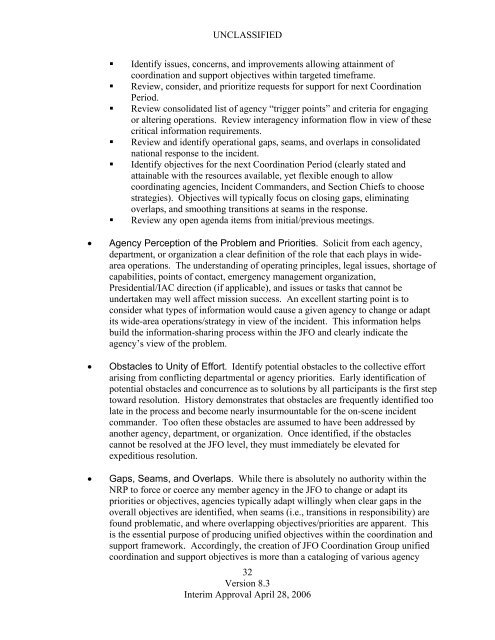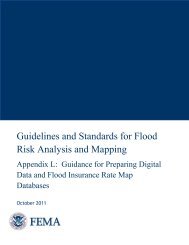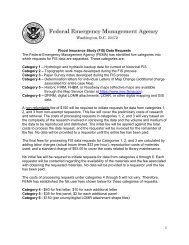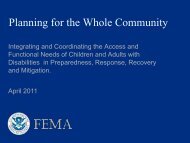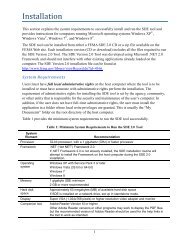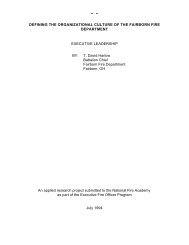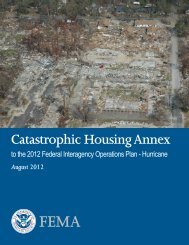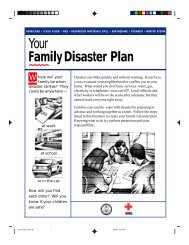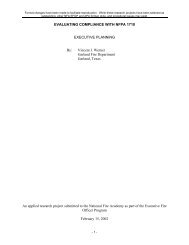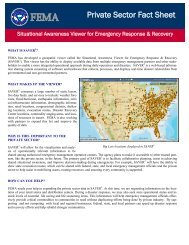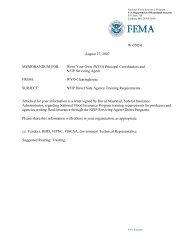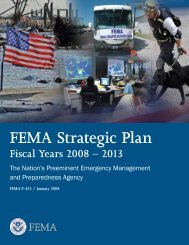Joint Field Office Activation and Operations - Federal Emergency ...
Joint Field Office Activation and Operations - Federal Emergency ...
Joint Field Office Activation and Operations - Federal Emergency ...
You also want an ePaper? Increase the reach of your titles
YUMPU automatically turns print PDFs into web optimized ePapers that Google loves.
UNCLASSIFIED• Identify issues, concerns, <strong>and</strong> improvements allowing attainment ofcoordination <strong>and</strong> support objectives within targeted timeframe.• Review, consider, <strong>and</strong> prioritize requests for support for next CoordinationPeriod.• Review consolidated list of agency “trigger points” <strong>and</strong> criteria for engagingor altering operations. Review interagency information flow in view of thesecritical information requirements.• Review <strong>and</strong> identify operational gaps, seams, <strong>and</strong> overlaps in consolidatednational response to the incident.• Identify objectives for the next Coordination Period (clearly stated <strong>and</strong>attainable with the resources available, yet flexible enough to allowcoordinating agencies, Incident Comm<strong>and</strong>ers, <strong>and</strong> Section Chiefs to choosestrategies). Objectives will typically focus on closing gaps, eliminatingoverlaps, <strong>and</strong> smoothing transitions at seams in the response.• Review any open agenda items from initial/previous meetings.• Agency Perception of the Problem <strong>and</strong> Priorities. Solicit from each agency,department, or organization a clear definition of the role that each plays in wideareaoperations. The underst<strong>and</strong>ing of operating principles, legal issues, shortage ofcapabilities, points of contact, emergency management organization,Presidential/IAC direction (if applicable), <strong>and</strong> issues or tasks that cannot beundertaken may well affect mission success. An excellent starting point is toconsider what types of information would cause a given agency to change or adaptits wide-area operations/strategy in view of the incident. This information helpsbuild the information-sharing process within the JFO <strong>and</strong> clearly indicate theagency’s view of the problem.• Obstacles to Unity of Effort. Identify potential obstacles to the collective effortarising from conflicting departmental or agency priorities. Early identification ofpotential obstacles <strong>and</strong> concurrence as to solutions by all participants is the first steptoward resolution. History demonstrates that obstacles are frequently identified toolate in the process <strong>and</strong> become nearly insurmountable for the on-scene incidentcomm<strong>and</strong>er. Too often these obstacles are assumed to have been addressed byanother agency, department, or organization. Once identified, if the obstaclescannot be resolved at the JFO level, they must immediately be elevated forexpeditious resolution.• Gaps, Seams, <strong>and</strong> Overlaps. While there is absolutely no authority within theNRP to force or coerce any member agency in the JFO to change or adapt itspriorities or objectives, agencies typically adapt willingly when clear gaps in theoverall objectives are identified, when seams (i.e., transitions in responsibility) arefound problematic, <strong>and</strong> where overlapping objectives/priorities are apparent. Thisis the essential purpose of producing unified objectives within the coordination <strong>and</strong>support framework. Accordingly, the creation of JFO Coordination Group unifiedcoordination <strong>and</strong> support objectives is more than a cataloging of various agency32Version 8.3Interim Approval April 28, 2006


